
Page 53: of Maritime Reporter Magazine (November 2021)
The Workboat Edition
Read this page in Pdf, Flash or Html5 edition of November 2021 Maritime Reporter Magazine
TECH FEATURE CONTAINERSHIPPING & SUSTAINABILITY duction makes it one of the most environmentally friendly fu- “We’ve shown that there els currently available. Robert Eriksson, Senior Concept Engi- neer, Business Concepts, Kongsberg Maritime, explains: “Use are some de? nite OPEX of dual-fuel engines and LNG contributes to signi? cant emis- bene? ts to using LNG sions savings over MGO, from 14-21% depending on the en- and our PTO strategies, gine,” he said. “This takes into account pilot fuel use and meth- ane slip, as well as LNG use. It also has a signi? cant effect on but what about CAPEX?
OPEX; teamed with careful management of power generation
Installing a PTO can capacity, we believe savings of up to 20% can be achieved.” pay for itself, as they are
A key difference between container ships and other vessels is the sheer amount of power required. “Container vessels can cheaper than generator sets, but there’s consume huge amounts of electricity, especially when carry- no doubt that LNG systems are more ing refrigerated containers,” said Eriksson. “Therefore, you see quite big gensets on these vessels. LNG-fuelled vessels expensive – up to $20m more than for tend to have two-stroke dual-fuel engines for propulsion and an MGO-fuelled vessel. But we did some four-stroke dual-fuel engines for auxiliary power. These aux- calculations, and the additional machinery iliary engines can be bigger than many other ships’ main en- gines, and you’ll usually have at least four of these gensets on costs can be offset by the ef? ciency savings board. If we can reduce their use and/or number, we can save over a period of between 10 and 15 years, both emissions and running costs.” taking ? nancing costs into account.”
KM’s solution to this high-power demand is to add a shaft generator to the main, two-stroke propulsion engine as a pow- er take off (PTO): a more ef? cient arrangement than running – Paul Fredrik Gjerpe, Vice President, auxiliary generator sets. The aim is that, through use of PTOs,
Business Concepts, Kongsberg Maritime some of these engines need not be used at all – or even ? tted, in the case of newbuild vessels. Research carried out by KM’s
Business Concepts team proposes that, by adding a PTO, a around 2% and CO2 equivalent emissions by up to 3%.
14,000 TEU vessel – which might typically use a 50MW, two- “Using a PTO reduces overall running hours for the generator stroke propulsion engine and four 4,240kW four-stroke aux- sets,” said Eriksson. “The propulsion engines are running any- iliary generator sets – can be more ef? ciently powered using way, so by using a PTO we just take advantage of unused capac- just three generator sets and the PTO output from the main ity. This allows one or more generator sets to be shut down. In engine. Generator sets cost more than PTOs, so this represents addition, the larger cylinder sizes of the two-stroke propulsion a signi? cant CAPEX saving, as well as reducing OPEX by engines are inherently more ef? cient, so it’s a win-win situation.”
ENDLESS SUPPLY OF MARINE HARDWARE ! &"$)$?""?!!&"$l • New, Used and Rental Options Available
AUTHORIZED YOKOHAMA • New Harness Installation 0r Harness Repair with Quick Turnaround
FENDER DISTRIBUTOR • Foam and Pneumatic Fenders Available
NEW & USED LARGEST INVENTORY IN THE USA
IN STOCK &
READY TO SHIP • Anchors • b?m]v • Hardware • ou7-]; • Dock • Buoys
WORLDWIDE • Chains • $o?bm] • Wire Rope • Blocks • Fenders • Spill Boom 24/7 ?????ƒƒƒ??????!!&"$l www.marinelink.com 53
MR #11 (50-65).indd 53 11/5/2021 12:41:34 PM

 52
52

 54
54
